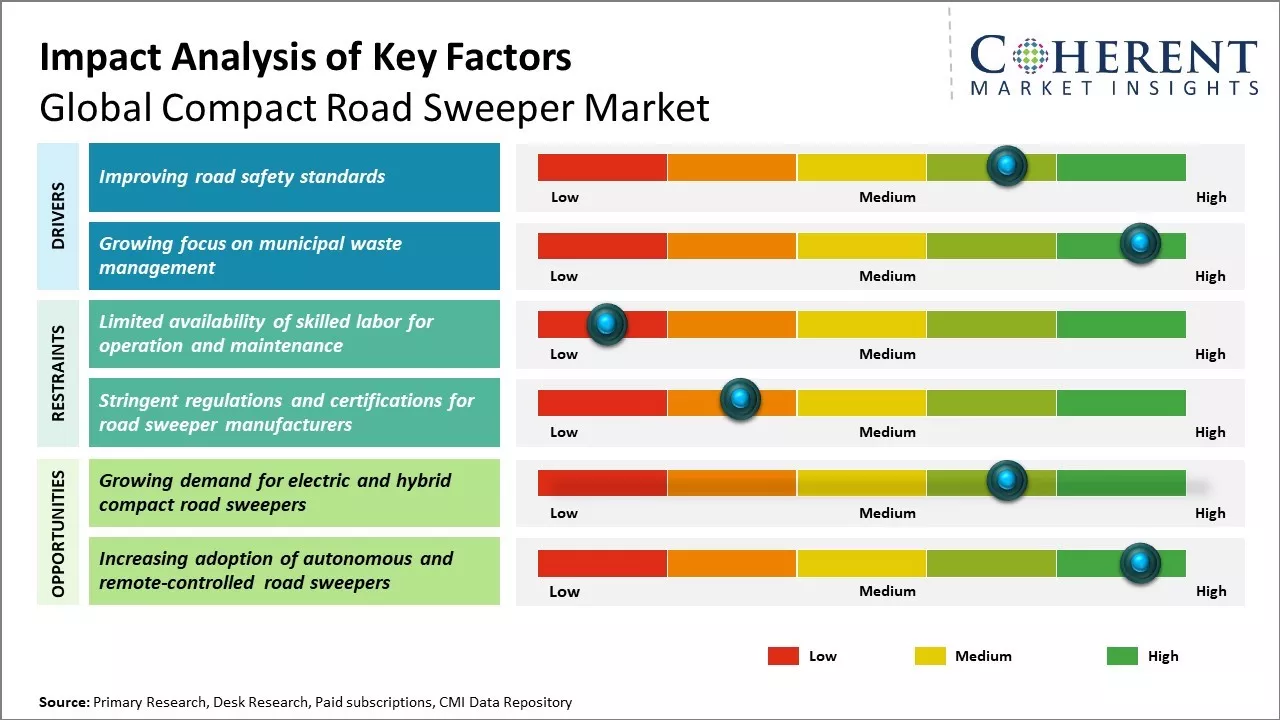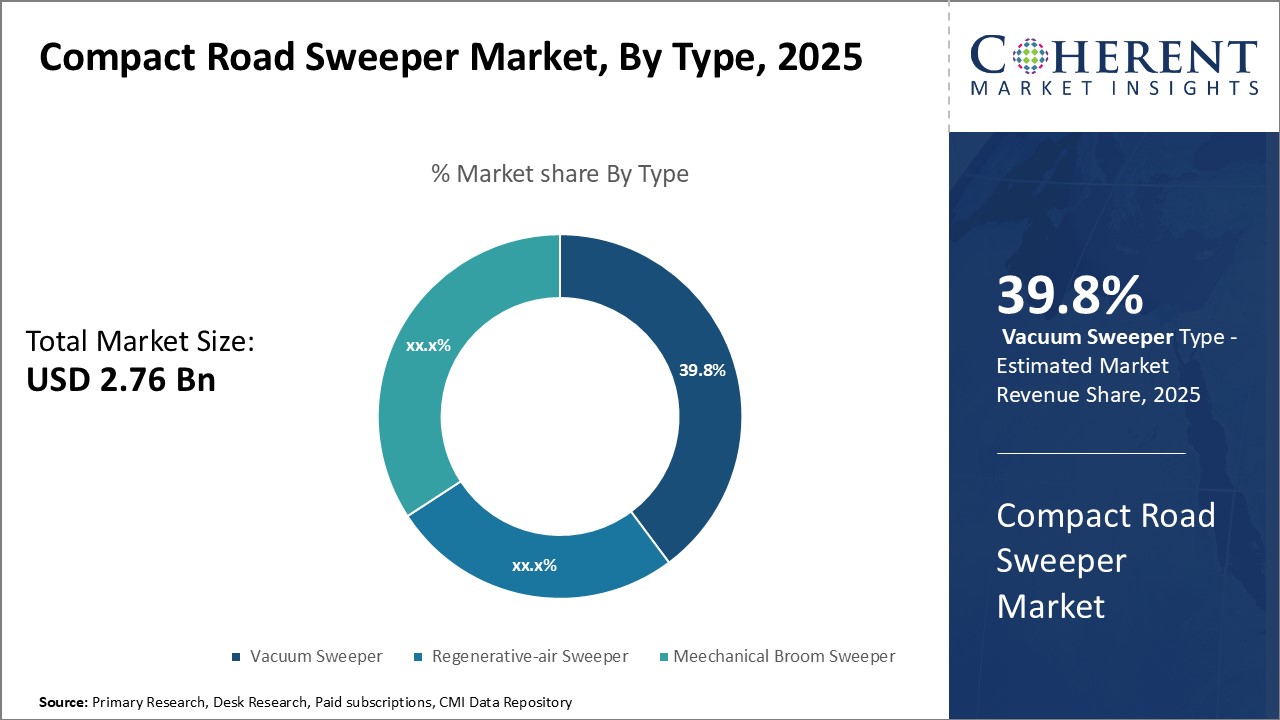Compact Road Sweeper Market Size and Trends
The global compact road sweeper market is estimated to be valued at US$ 2.76 Bn in 2025 and is expected to reach US$ 3.79 Bn by 2032, exhibiting a compound annual growth rate (CAGR) of 4.6% from 2025 to 2032. Compact road sweepers are witnessing increasing adoption for the maintenance of smaller roads and paths. The demand is driven by the need for the efficient cleaning of urban streets and roads that require machines with superior maneuverability.

Discover market dynamics shaping the industry: Download Free Sample
Increasing urbanization and construction activities have boosted the requirement for the maintenance of inner-city roads, pathways, and pedestrian zones. This has augured well for compact sweepers that efficiently clear debris in tight spaces with their compact sizes and advanced filtering mechanisms.
Improving road safety standards
With rapid urbanization and rising motor vehicle usage across major cities, road safety has become an important issue to address for local administrations. Regular street cleaning plays a vital role in maintaining suitable driving conditions and preventing accidents. Compact road sweepers have enabled municipalities to more efficiently clear debris and potential hazards from streets. Their maneuverability allows them to navigate narrow alleys and busy roads. By removing dust, leaves, bottle shards, and other impediments, compact sweepers help reduce slippage and improve visibility for motorists. This enhances traffic flow and reduces the risk of crashes or collisions. Many countries have now instituted rules mandating regular scheduled sweeping, especially in commercial areas. This is bolstering the need for cost-effective sweepers that can be deployed for ongoing maintenance. With urbanization set to continue globally, the demand for compact road sweepers will rise further as civic bodies prioritize public safety on city streets.
Market Concentration and Competitive Landscape

Get actionable strategies to beat competition: Download Free Sample
Growing focus on municipal waste management
Sweeping and cleaning of roads is a crucial part of maintaining hygienic public spaces in urban conglomerations. However, inadequate infrastructure and budget constraints have been an impediment for waste management teams of many municipal corporations. Compact road sweepers have provided a practical solution as they require less space for operation and maintenance compared to full-sized models. They can maneuver through narrow lanes and easily access every corner of the city. This has allowed municipal groups to step up cleaning schedules and cover broader areas within set budgets. At the same time, compact sweepers produce less noise and emissions, addressing another policy priority. Some models even offer optional upgraded filtration systems for improving local air quality. The compact form factor also enables easy relocation of sweepers between divisions as needed. Their efficiency and versatile functionality is supporting municipal solid waste management targets of numerous cities and sizeable investments in fleet expansion.
Key Takeaways from Analyst:
The North America region will continue dominating the global compact road sweeper landscape owing to massive infrastructure development projects underway. Asia Pacific countries are also likely to maintain their position among the top revenue generators. Asia Pacific is set to emerge as the fastest growing regional market, supported by rising commercial and residential construction activities.
Within compact sweepers, walk-behind models will remain the largest category owing to their ease of use for small cleaning jobs. Rider models are gaining increasing popularity due to their ability to sweep wider areas at a faster rate. Hybrid and electric-based variants also provide new growth opportunities with their eco-friendly credentials and lower operating costs over diesel/gasoline-powered sweepers.
Leading manufacturers are focusing on integrating innovative features such as vacuuming, mulching, and debris collection capabilities to enhance operational efficiency.
Market Challenges: Limited availability of skilled labor for operation and maintenance
The availability of skilled labor is one of the key challenges restraining the growth of the compact road sweeper market. Compact road sweepers require trained operators who can efficiently operate and maintain these machines. Obtaining such trained personnel is becoming increasingly difficult for compact road sweeper manufacturers and rental companies.
Operating a compact road sweeper is quite different compared to conventional road sweepers, as these machines have smaller dimensions and higher maneuverability, which allows them to effectively clean narrow streets and tight spaces. However, this also means the controls are more sensitive which needs experience to handle. Regular maintenance of various mechanical and electrical components also demands technical expertise. With rapid urbanization, infrastructure development and construction activities on the rise, the demand for compact road sweepers has been increasing significantly. However, the limited availability of skilled workforce who have thorough knowledge about the functioning and upkeep requirements of these machines has been a bottleneck.
Market Opportunities: Growing demand for electric and hybrid compact road sweepers
The compact road sweeper market is poised to benefit tremendously from the rising demand for electric and hybrid sweepers. With an increasing focus on sustainability and reducing carbon emissions, more cities and municipalities are looking to transition their street cleaning fleets towards zero or low-emission options. Compact electric sweepers are ideal for cleaning streets and sidewalks in dense urban areas due to their small size and maneuverability. They offer significant benefits over traditional diesel models by producing no tailpipe emissions. This allows local governments to improve air quality and public health in the communities they serve.

Discover high revenue pocket segments and roadmap to it: Download Free Sample
Insights By Type - Product Innovation Fuels Vacuum Sweeper Dominance
In terms of type, vacuum sweeper is expected to contribute 39.8% share of the global compact road sweeper market in 2025 owing to ongoing innovation that improves their performance and value proposition. Vacuum sweepers effectively pick up fine debris and dust that other sweepers miss through powerful suction generated by their spinning brooms and fans. This allows them to deeply clean pavement and capture particles as small as 2-5 microns, protecting drainage systems and reducing environmental and health impacts from airborne pollutants.
Leading makers continuously upgrade vacuum sweepers' suction power and filtration efficiency. New models feature higher airflow volume, more durable filter bags, and automated filter-shaking mechanisms to prevent clogging. Some even integrate wet-dust suppression systems that spray water mist ahead of the broom to control dust during sweeping. These technological enhancements boost vacuum sweepers' cleaning versatility and suitability for dealing with fine construction rubbish or industrial spills.
Ergonomic and safety features on modern vacuum sweepers also offer significant advantages over mechanical brooms and regenerative models. Low-emission engines, enclosed cabins with climate control, and noise cancellation, as well as intuitive controls that minimize operator fatigue, strengthen their value in applications requiring long work shifts. Onboard weighing systems provide payload monitoring to optimize waste collection routes. These user-centric innovations fuel demand from contractors seeking to improve workplace conditions and productivity.
Vacuum sweepers' higher upfront costs versus alternatives are increasingly offset by lower lifetime operating expenses. More durable components mean longer service intervals and less downtime for repair or maintenance. Efficient dust containment eliminates follow-up dust suppression needs and associated water/chemical consumption. Combined with less strain on workers, vacuum sweepers deliver superior cost-effectiveness that cements their primacy in the compact road sweeper segment.
Insights By Application - Municipal Projects Propel Demand from the Public Sector
In terms of application, municipal is expected to contribute 41.9% share of compact road sweeper usage globally in 2025. Tight budgets pressure local governments to maximize existing infrastructure lifespan through diligent cleaning and maintenance. Compact sweepers are ideally sized for residential streets and cycling paths yet powerful enough to clean urban arterial roads.
Cities worldwide allocate more spending toward green initiatives like improving air quality, recycling rates, and stormwater management. Compact sweepers cleanly collect debris before it washes into waterways or becomes airborne, supporting sustainability goals. Many municipalities purchase models featuring advanced dust control and onboard scales to track waste diversion.
Population growth brings higher traffic volumes that deposit more fines on urban surfaces. Compact sweepers' maneuverability lets them efficiently tackle spillages and promptly reopen blocked lanes. This maintains traffic flow and minimizes disruption, enhancing public safety. Regularity of routine sweeping also uplifts neighborhood curb appeal which councils must balance against tight budgets.
Contracted maintenance firms depend on municipal sweeping contracts as a steady revenue source. They select compact sweepers as the optimal equipment for recurring small-scale projects and supplemental largescale jobs. Strong relationships between sweepers suppliers and these contractors further stimulates municipal sales. Hence compact sweeper demand from public works departments remains the bedrock for overall market success.
Regional Insights

Need a Different Region or Segment? Download Free Sample
North America dominates the global compact road sweeper market. The region is expected to account for 37.6% of the market share in 2025 owing to strong infrastructure and stringent municipal laws regarding clean streets. The region is home to some of the largest players in the sweeper industry who have built a robust supply chain and excellent after-sales service networks across major cities. This enables them to quickly address municipalities' requirements for new equipment as well as breakdown issues. The competitive bidding process in public contracts also encourages the localization of production, giving North American manufacturers an added advantage.
One region that is emerging as the fastest growing market for compact sweepers is Asia Pacific. Rapid urbanization and investment in infrastructure development across developing nations, such as India and Indonesia, have increased the demand for modern road cleaning equipment. Local municipalities now recognize the need for mechanized sweepers as a more effective solution compared to manual cleaning. This has attracted several global OEMs to establish manufacturing plants in the region to serve the rising local needs as well as explore export potential. For example, some European brands now locally source key components, helping reduce production costs, and give a competitive edge in bidding.
The free trade agreements among Asia Pacific countries have also aided in increasing the import and export of sweepers within the region. For instance, Indian compact sweeper manufacturers have been able to gain traction in Southeast Asian nations due to lower tariffs. Meanwhile, Chinese OEMs are leveraging their low-cost manufacturing capabilities to gradually expand their reach in South Asian markets. The differential pricing and financing options further promote sales growth. However, quality standards and safety regulations still vary across Asia Pacific which manufacturers must consider based on target countries.
Overall, while North America continues dominating with established infrastructure, Asia Pacific is emerging as the future growth driver of the global compact road sweeper industry. The massive ongoing investments in transportation and urban planning projects in the developing Asian countries will ensure the demand remains robust over the coming years. Both regions present lucrative opportunities for existing as well as new entrants in the sweeper manufacturing industry.
Market Report Scope
Compact Road Sweeper Market Report Coverage
| Report Coverage | Details | ||
|---|---|---|---|
| Base Year: | 2024 | Market Size in 2025: | USD 2.76 Bn |
| Historical Data for: | 2020 To 2024 | Forecast Period: | 2025 To 2032 |
| Forecast Period 2025 to 2032 CAGR: | 4.6% | 2032 Value Projection: | USD 3.79 Bn |
| Geographies covered: |
|
||
| Segments covered: |
|
||
| Companies covered: |
Aebi Schmidt, Alamo Group, Bucher (Johnston), Dulevo International, Elgin Sweeper Company, Exprolink, FAUN, FAYAT GROUP, FULONGMA, Hako, Henan Senyuan Heavy Industry, KATO, Nilfisk, Tennant, and ZOOMLION |
||
| Growth Drivers: |
|
||
| Restraints & Challenges: |
|
||
Uncover macros and micros vetted on 75+ parameters: Get instant access to report
Market Segmentation
- Type Insights (Revenue, US$ Bn, 2020 - 2032)
- Mechanical Broom Sweeper
- Regenerative-air Sweeper
- Vacuum Sweeper
- Application Insights (Revenue, US$ Bn, 2020 - 2032)
- Municipal
- Airport
- Industrial
- Regional Insights (Revenue, US$ Bn, 2020 - 2032)
- North America
- U.S.
- Canada
- Latin America
- Brazil
- Argentina
- Mexico
- Rest of Latin America
- Europe
- Germany
- U.K.
- Spain
- France
- Italy
- Russia
- Rest of Europe
- Asia Pacific
- China
- India
- Japan
- Australia
- South Korea
- ASEAN
- Rest of Asia Pacific
- Middle East & Africa
- GCC Countries
- Israel
- South Africa
- Rest of Middle East & Africa
- North America
- Key Players Insights
- Aebi Schmidt
- Alamo Group
- Bucher (Johnston)
- Dulevo International
- Elgin Sweeper Company
- Exprolink
- FAUN
- FAYAT GROUP
- FULONGMA
- Hako
- Henan Senyuan Heavy Industry
- KATO
- Nilfisk
- Tennant
- ZOOMLION
Share
Share
About Author
Gautam Mahajan is a Research Consultant with 5+ years of experience in market research and consulting. He excels in analyzing market engineering, market trends, competitive landscapes, and technological developments. He specializes in both primary and secondary research, as well as strategic consulting across diverse sectors.
Missing comfort of reading report in your local language? Find your preferred language :
Transform your Strategy with Exclusive Trending Reports :
Frequently Asked Questions
EXISTING CLIENTELE
Joining thousands of companies around the world committed to making the Excellent Business Solutions.
View All Our Clients
